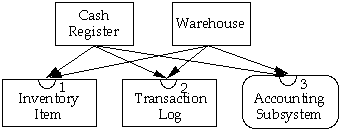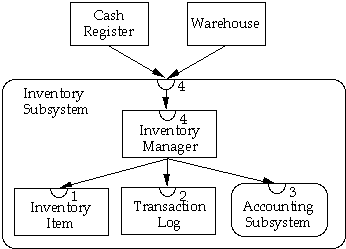
|
CS 535 Object-Oriented Programming
Spring Semester, 2003
OO Design Analysis Phase
|
|
|
|
Previous
Lecture Notes Index
Next
© 2003, All Rights Reserved, SDSU & Roger Whitney
San Diego State University -- This page last updated 17-Apr-03
|
|
Contents of Doc 19, OO Design Analysis Phase
References
Designing
Object-Oriented Software, Wirfs-Brock, chapters 6 - 8
Overview
of Design Process
Exploratory
Phase
- Finding
the objects
- Determining
responsibilities
- Finding
collaborations
Analysis
Phase
- Finding
hierarchies
- Finding
subsystems
- Refining
the design
Analysis
Phase
- Determine
which classes are related via inheritance
- Finding
abstract classes
- Determine
class contracts
- Finding
Object Interaction
- Divide
responsibilities into subsystems
- Designing
interfaces of subsystems and classes
- Construct
protocols for each class
- Produce
a design specification for each class and subsystem
- Write
a design specification for each contract
Hierarchies
Hierarchy Graphs

Venn Diagrams

Building
Good Hierarchies
Model
a "kind-of" hierarchy
Multiple
inheritance can be used in the design even if you use an implementation
language with single inheritance.
Make
sure that abstract classes do not inherit from concrete classes
Eliminate
classes that do not add functionality
Factor
common responsibilities as high as possible



Identifying
Contracts
Contract
- Set
of requests that a client can make of a server
- Cohesive
set of responsibilities that a client can depend on
- Abstraction
of a set of responsibilities of a class
Example:
Account Class
- Contract:
Access and modify the account balance
- Responsibilities:
- Know
the account balance
- Accept
deposits
- Accept
withdrawals
Identifying
Contracts
Group
responsibilities used by the same clients
Maximize
the cohesiveness of classes
- Contract
of a class should make sense together
Minimize
the number of contracts
-
- Use
inheritance
- Set
of classes all supporting a common contract should inherit the contract from a
common superclass
Applying
the Guidelines
- Start
defining contract at the top of the hierarchies
- Name
and number each contract
- For
each collaboration, determine which contract represents that collaboration
Subsystems
Subsystems
are groups of classes, or groups of classes and other subsystems, that
collaborate among themselves to support a set of contracts
There
is no conceptual difference between the responsibilities of a class and a
subsystem of classes
The
difference between a class and subsystem of classes is a matter of scale
A
subsystem should be a good abstraction
There
should be as little communication between different subsystems as possible

Top-Down,
Bottom-Up
Large Systems
Most
texts illustrate OO design "bottom-up"
- Find
objects
- Determining
responsibilities
- Determine
object collaboration
- Find
hierarchies
- Determine
subsystems
Large
systems are designed "top-down"
- Find
top level subsystems
- Determine
subsystem responsibilities
- Determine
subsystem collaboration
- Find
hierarchies
- Iterate
above steps on each subsystem
Each
level is built "bottom-up"
Levels
are done "top-down"
Top-Down,
Bottom-Up
Large Systems
Jacobson,
1991
"The
subsystem division in small projects is normally made at the end of the
analysis, when the architecture is clear. In larger projects, however, it
often must be done earlier, in many cases even before the analysis model has
been developed."
"In
large systems it is often essential to develop the system in layers."
"For
large projects there may be other criteria for subsystem division, for example:
- Different
specialties in different development groups
- If
an existing product is to be used in the system, it may be regarded as a
subsystem
- In
a distributed environment, a subsystem may be wanted at each logical node"
Collaboration
Graphs

Subsystem Contracts
A
subsystem contract consists of all class contracts that provide services to
clients outside the system
Subsystem
contracts can be extended
Subsystem
Cards


Class Cards

Identifying
Subsystems
All
objects which have strong coupling should be placed in the same subsystem
There
should be as little communication between different subsystems as possible
Does
a set of classes make sense as an abstraction?
Can
you name a group of classes?
Does
a group of classes interact frequently?
Simplifying
Interactions
Subsystems
- Reduce
complexity of a design
- Provide
coherent structure to the design
Minimize
the number of collaborations a class has with other classes or subsystems
- Reassign
responsibilities or expand the knowledge of another class to create fewer
collaborations
- Create
subsystem to reduce collaborations
Minimize
the number of classes and subsystems to which a subsystem delegates
Minimize
the number of different contracts supported by a class or a subsystem
- Too
many contracts in one subsystem can be a sign that the subsystem has too much
intelligence



Protocols
Construct
protocols for each class
- Specify
the signatures for the methods that each class will implement
Write
a design specification for each class and subsystem
Write
a design specification for each contract
Refining
Responsibilities
Turn
contracts into protocols
Account
contract 1
- Access
and modify the account balance
- Know
the account balance
- Accept
deposits
- Accept
withdrawals
-
- Protocols
- balance()
returns Fixed Point Number
- deposit(Fixed
Point Number)
- withdraw(Fixed
Point Number)
In
general, private responsibilities represent designs notes to an implementers
Select
operation names carefully
- Don't
use one name to mean two different things
- Don't
use two names for the same thing
Make
protocols as generally useful as possible
Refining
Responsibilities
Define
reasonable defaults
- First,
define the most general message, one that allows clients to supply all possible
required parameters
- Next,
provide default values for any parameter for which it is reasonable to do so
- Finally,
analyze how each client uses this general message. From that analysis, define
a set of messages that allows clients to specify only some of the parameters,
while relying on defaults for the others.
Refining
Responsibilities
Define
reasonable defaults
Example:
Display of Drawing Elements
- Parameters
- Display
device
–
printer or screen
- Display
region
–
clipping region
- Drawing
rule
– how
to combine new bits with old
- Transformation
–
from element space to display space
-
- Defaults
- Display
device
–
active window
- Display
region
–
entire medium
- Drawing
rule
– over,
completely replace old bits
- Transformation
–
identity
- Protocol
- display()
- display(Display
Device)
- display(Region)
- display(Display
Device, Region)
- display(Display
Device, Region, Drawing Rule)
- display(Display
Device, Region, Drawing Rule, Transformation)
Specifying
the Design
Classes
Class:
Drawing
(Concrete)
Superclasses:
Displayable Object
Subclasses:
none
Hierarchy
Graphs:
page 5
Collaborations
Graph:
page 8
Description:
This class represents the structure of ...
Contracts
1.
Display
itself
This
contract is inherited from Displayable Object
2. Maintain
the elements in a drawing
-
- Know
which elements are contained in the drawing
- addElement
(Drawing Element)
- uses
List
- This
method adds a drawing element ...
- elementAt
(Point) returns Drawing Element
- uses
List, Drawing Element (3)
- This
method returns the first drawing ...
Specifying
the Design
Classes
- Write
the class name and state whether the class is abstract or concrete
- its
immediate superclasses and subclasses
- Provide
class's position in the hierarchy and collaboration graphs
- Describe
the purpose of the class and its intended use
- List
each contract for which the class is a server
- For
each contract, list the responsibilities of the class that support it. Under
each responsibility, write the signatures of the methods that implement the
responsibility. Include a brief description and note the collaborations
required. Don't neglect error conditions; specify the behavior of the method
for all given inputs.
- List
the private responsibilities that have been defined
- Include
other relevant information:
- behavioral
constraints
- implementation
considerations
Specifying
the Design
Subsystems
Subsystem:
Drawing Subsystem
Classes:
Control Point, Drawing, Drawing Element, Ellipse Element, Filled Element,
Group Element, Line Element, Linear Element, Rectangle Element, Text Element
Collaborations
Graphs:
pages 6 and 8
Description:
The Drawing subsystem is responsible for displaying, maintaining the contents
of a drawing. The Drawing Subsystem supports three contracts. Two are
supported by ...
Contracts
1. Display
itself
- This
contract is defined by Displayable Object, and supported by Drawing
- Server:
Drawing
2. Access
and modify the contents of a drawing
- Server:
Drawing
3. Modify
the attributes of a Drawing Element
- Server:
Control Point
Specifying
the Design
Subsystems
- Write
the subsystem name at the top of the page
- List
all encapsulated classes and subsystems
- Provide
subsystems position in the hierarchy and collaboration graphs
- Describe
the purpose of the subsystem
- List
the contracts for which this subsystem is a server
- For
each contract, identify the class or subsystem to which the contract is delegated
Specifying
the Design
Formalizing Contracts
Contract
3:
Modify the attributes of a drawing element
Server:
Control Point
Client:
Selection Tool
Description:
This contract allows modification of a drawing element through the manipulation
of a control point associated with that element. The result of moving the
control point is specified by the drawing element at the time the control point
is created.
For
each contract include:
-
- Contract
name and number
- Server(s)
- Clients
- Description
of the contract
Copyright ©, All rights reserved.
2003 SDSU & Roger Whitney, 5500 Campanile Drive, San Diego, CA 92182-7700 USA.
OpenContent license defines the copyright on this document.
Previous
 visitors since 17-Apr-03
Next
visitors since 17-Apr-03
Next














